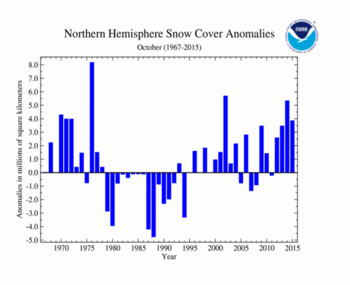NH Snow Cover Extent
| October 2015 | Snow Cover Extent | Anomaly 1991-2020 | Trend per decade | Rank (48 years) | Record | ||||||
|---|---|---|---|---|---|---|---|---|---|---|---|
| million km² | million mi² | million km² | million mi² | million km² | million mi² | Year(s) | million km² | million mi² | |||
| Northern Hemisphere | 21.40 | 8.26 | +2.23 | +0.86 | +0.22 | +0.08 | Largest | 7th | 1976 | 25.72 | 9.93 |
| Smallest | 42nd | 1988 | 12.78 | 4.93 | |||||||
| North America | 8.73 | 3.37 | +0.25 | +0.10 | +0.08 | +0.03 | Largest | 10th | 2002 | 9.76 | 3.77 |
| Smallest | 39th | 1979 | 6.36 | 2.46 | |||||||
| Ties: 1986 | |||||||||||
| Eurasia | 12.67 | 4.89 | +1.99 | +0.77 | +0.14 | +0.05 | Largest | 6th | 1976 | 17.22 | 6.65 |
| Smallest | 43rd | 1988 | 5.58 | 2.15 | |||||||
Data Source: Global Snow Laboratory, Rutgers University. Period of record: 1967–2015 (48 years)
During October 2015, the Northern Hemisphere snow cover extent (SCE) was 21.40 million square km (8.26 million square miles), 3.86 million square km (1.49 million square miles) above the 1981-2010 average. This was the seventh largest October SCE in the 48-year period of record for the Northern Hemisphere. Both North America and Eurasia had above average SCE.
The October North American SCE was 8.73 million square km (3.37 million square miles), 680,000 square km (260,000 square miles) above average and the 11th largest on record. For October, the contiguous U.S. SCE was the eighth smallest on record, while Alaskan SCE was the 22nd largest and, Canadian SCE was eighth largest. Below-average snow cover was observed across the U.S. and Canadian Rockies, the Canadian Prairies, and western Alaska. Above-average snow cover was observed across eastern Alaska, and northern and eastern Canada.
The Eurasian SCE during October was 12.67 million square km (4.89 million square miles), 3.17 million square km (1.22 million square miles) above average. This was the sixth largest October SCE on record for Eurasia. Below-average snow cover was observed across the Tibetan Plateau. Above-average snow cover was observed across most of Russia, especially western Russia, Mongolia, and parts of the Himalayas.
Sea Ice Extent
| October 2015 | Sea Ice Extent | Anomaly 1991-2020 | Trend per decade | Rank (37 years) | Record | ||||
|---|---|---|---|---|---|---|---|---|---|
| million km² | million mi² | Year(s) | million km² | million mi² | |||||
| Northern Hemisphere | 6.97 | 2.69 | -6.94% | -9.75% | Largest | 33rd | 1986 | 9.48 | 3.66 |
| Smallest | 5th | 2012 | 5.89 | 2.27 | |||||
| Southern Hemisphere | 18.41 | 7.11 | +0.99% | +1.15% | Largest | 11th | 2013 | 19.02 | 7.34 |
| Smallest | 27th | 1986 | 17.18 | 6.63 | |||||
| Globe | 25.38 | 9.80 | -1.32% | -2.02% | Largest | 32nd | 1980 | 27.75 | 10.71 |
| Smallest | 6th | 2012 | 24.48 | 9.45 | |||||
Data Source: National Snow and Ice Data Center (NSIDC). Period of record: 1979–2015 (37 years)
According to the National Snow and Ice Data Center (NSIDC), the Northern Hemisphere (Arctic) sea ice extent — which is measured from passive microwave instruments onboard NOAA satellites — averaged for October 2015 was 7.72 million square km (2.98 million square miles), 1.19 million square km (460,000 square miles), or 13.36 percent, below the 1981-2010 average. This was the sixth smallest October extent in the 37-year satellite record and the smallest since 2012. Below-average sea ice was observed in the Chukchi Sea on the Pacific side of the Arctic and the Kara and Barents Seas on the Atlantic side. Near-average sea ice was observed in the East Greenland Sea. Overall, October Arctic sea ice extent is decreasing at an average rate of 6.73 percent per decade.
The October 2015 Southern Hemisphere (Antarctic) sea ice extent was 18.56 million square km (7.17 million square miles), 230,000 square km (90,000 square miles), or 1.25 percent, above the 1981-2010 average. This was the 14th largest October Antarctic sea ice extent on record, but the smallest since 2011. October Antarctic sea ice extent is increasing at an average rate of 1.15 percent per decade. On October 6th the Antarctic sea ice reached its annual maximum extent at 18.83 million square km (7.24 million square miles), 120,000 square km (46,000 square miles) above the 1981-2010 average maximum extent. This was the 16th largest maximum on record, and in contrast to the past three years when record large maximum sea ice extents were observed.
When combining the Northern Hemisphere and Southern Hemisphere sea ice extents, the globally-averaged sea ice extent during October was 26.28 million square km (10.15 million square miles), 3.52 percent below the 1981-2010 average and the fifth smallest October global sea ice extent on record. This was the smallest October global sea ice extent since 2012. October global sea ice extent is decreasing at an average rate of 1.40 percent per decade.
For further information on the Northern and Southern Hemisphere snow and ice conditions, please visit the NSIDC News page.
 NOAA's National Centers for Environmental Information
NOAA's National Centers for Environmental Information




